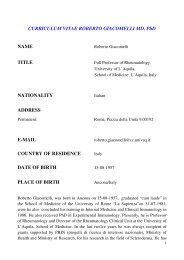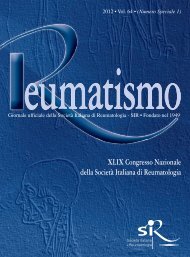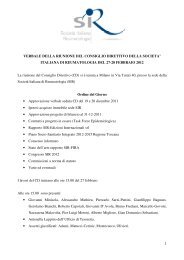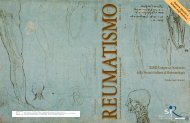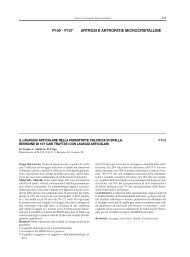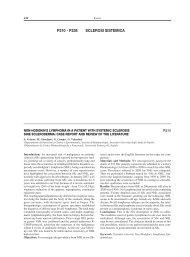M. Mosca (Pisa), R. Perricone (Roma) - Sir
M. Mosca (Pisa), R. Perricone (Roma) - Sir
M. Mosca (Pisa), R. Perricone (Roma) - Sir
Create successful ePaper yourself
Turn your PDF publications into a flip-book with our unique Google optimized e-Paper software.
120 N. Pipitone, C. Salvarani<br />
each tool captures different facets of the same disease.<br />
This hampers the capacity of the physicians<br />
to correctly gauge the clinical course of myositis<br />
and to reliably discriminate between established<br />
muscle damage and ongoing disease activity. In an<br />
attempt to obviate these shortcomings, a consensus<br />
conference of the International Myositis Assessment<br />
and Clinical Studies Group (IMACS) has proposed<br />
a core set of disease activity measures consisting<br />
of five domains: physician and patient global<br />
assessments of disease activity; muscle strength;<br />
physical function; serum muscle enzymes; and an<br />
assessment tool to capture extraskeletal muscle disease<br />
activity (2). The committee of the consensus<br />
conference has also proposed as possible candidates<br />
for a core set of measures to assess damage<br />
in myositis (defined as changes that persist for at<br />
least six months despite prior therapy) the following<br />
tools: physician global damage assessment, the<br />
use of the HAQ, an assessment of the severity of<br />
damage of different organ systems using visual<br />
analog scales, and a modification of the Systemic<br />
Lupus International Collaborative Clinics - American<br />
College of Rheumatology damage index. Finally,<br />
the IMACS has published consensus guidelines<br />
for defining disease improvement and worsening<br />
(19). In particular, improvement has been<br />
defined as an at least 20% improvement in three of<br />
any six core set measures (physician’ global activity<br />
assessment, patient’s global activity assessment,<br />
muscle strength, physical function, muscle-associated<br />
enzymes, and extramuscular activity assessment),<br />
with no more than two worsening by 25%<br />
or more (measures that worsen cannot include manual<br />
muscle strength) (7) Criteria for disease worsening<br />
include a 20% or more worsening of the patient’s<br />
global condition as assessed by a physician,<br />
a 20% or more worsening of global extramuscular<br />
organ disease activity, and worsening of 30% or<br />
more of any three of six IMACS core set activity<br />
measure. The IMACS has recommended that these<br />
criteria be used in future trials of adult and juvenile<br />
dermatomyositis and PM.<br />
CONCLUSIONS AND SUGGESTIONS<br />
FOR THE CLINICAL PRACTICE<br />
Different parameters may be used to assess outcome<br />
in myositis, with assessment of muscle<br />
strength being the key tool. As shown herein, these<br />
parameters appear to only partially correlate with<br />
each other, which means that to best monitor disease<br />
activity a combination of various parameters<br />
should preferentially be used. Even so, sometimes<br />
it is difficult to determine whether persistent weakness<br />
is due to chronic damage or to active inflammation.<br />
Improvement in MMT scores in proximal<br />
muscles, especially if associated with improvement<br />
in serum CK levels and decreased edema on muscle<br />
MRI, would point to active disease responding<br />
to treatment. Persistent proximal muscle weakness<br />
despite therapy, on the other hand, may suggest<br />
chronic muscle damage, but also insufficient response<br />
to treatment, glucocorticoid-induced myopathy,<br />
deconditioning, or a combination of the<br />
above. MRI signs of chronic muscle damage (muscle<br />
atrophy and fat-replacement) are quite specific,<br />
therefore if persistent muscle weakness is found<br />
in association with these signs, the most likely diagnosis<br />
would be chronic damage of the affected<br />
muscles. It should be borne in mind, though, that<br />
active disease and chronic damage may coexist.<br />
There is insufficient data on muscle MR appearance<br />
in steroid myopathy.<br />
Assessment of myositis remains challenging, but<br />
using and interpreting correctly the available tools<br />
often allows to zero in on the actual cause of muscle<br />
weakness in the individual patient and to tailor<br />
treatment accordingly.<br />
REFERENCES<br />
1. Lundberg IE. Idiopathic inflammatory myopathies: why<br />
do the muscles become weak? Curr Opin Rheumatol.<br />
2001; 13 (6): 457-60.<br />
2. Miller FW, Rider LG, Chung YL, et al. Proposed preliminary<br />
core set measures for disease outcome assessment<br />
in adult and juvenile idiopathic inflammatory myopathies.<br />
Rheumatology (Oxford) 2001; 40 (11): 1262-<br />
73.<br />
3. Dayal NA, Isenberg DA. Assessment of inflammatory<br />
myositis. Curr Opin Rheumatol. 2001; 13 (6): 488-92.<br />
4. Hilton-Jones D. Diagnosis and treatment of inflammatory<br />
muscle diseases. J Neurol Neurosurg Psychiatry<br />
2003; 74 (Suppl 2): ii25-ii31.<br />
5. Dalakas MC, Hohlfeld R. Polymyositis and dermatomyositis.<br />
Lancet 2003; 362 (9388): 971-82.<br />
6. Kroll M, Otis J, Kagen L. Serum enzyme, myoglobin<br />
and muscle strength relationships in polymyositis and<br />
dermatomyositis. J Rheumatol 1986; 13 (2): 349-55.<br />
7. Rider LG, Giannini EH, Harris-Love M, et al. Defining<br />
clinical improvement in adult and juvenile myositis.<br />
J Rheumatol 2003; 30 (3): 603-17.<br />
8. Briani C, Doria A, Sarzi-Puttini P, Dalakas MC. Update<br />
on idiopathic inflammatory myopathies. Autoimmunity<br />
2006; 39 (3): 161-70.<br />
9. Genth E. Inflammatory muscle diseases: dermato-


